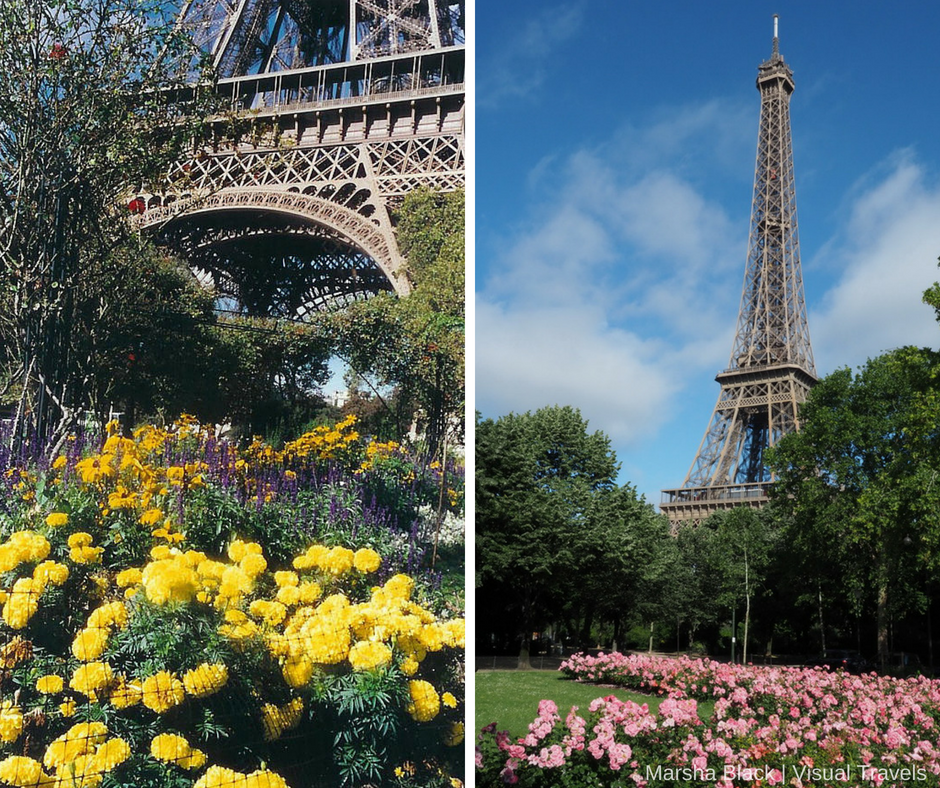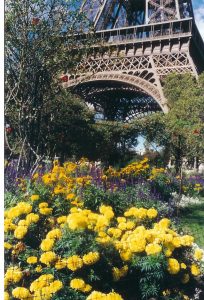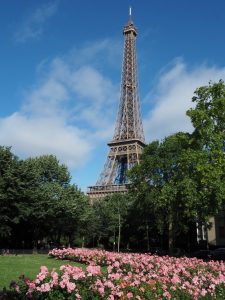I have traveled to many places in the world in my adult life, always with other people and often in groups. My traveling companions often comment that they never see me working with my camera as they look at the photos I take. I hear “I hardly notice your camera,” or “When did you take that?”
Most of us want good photos of our travels, and yet, often I hear people say “I stopped carrying a camera – gets in the way,” or, “I don’t want to be distracted with trying to take pictures,” or similar comments that assume travel and photographing anything in addition to photos of travel companions are too much work.
So, I wanted to share with you a few tips from my past and then my recent trip walking through Paris.

Start by Defining the Subject of your Travel Photography.
When I am traveling, whether far from home or near, I love to walk along and tell the story of what I am seeing through photographs. For example, I love the way gardens of flowers are often used to enhance the areas around major monuments.
Often I return to a place I have seen before and see dramatic changes which become part of the story. That happened recently when I was revisiting Paris after an absence of 14 years.
So, one of the first and most important things to decide as you walk through a place is what your story will be. What subject matter are you drawn to want to photograph, and what is the story about that subject that you want to tell?
For example, during a trip to Paris 14 years ago, my husband and I visited the Eiffel Tower, starting from the back of the Tower as seen from the Champs du Mars. I was immediately attracted to the bed of yellow flowers that seemed to wander through the garden to the base of the Tower. I wanted that image.

It illustrated a creative use of flowers at monument sites, and it had three of the four primary elements of a good photograph that make your subject stand out: angled lines, which show action, color which separated the subject from the surroundings, and patterns in both the base of the tower and in the flower bed. Light, which is the fourth and single most important element, was perfect that day – no backlighting, and no sun glare.
By getting down low and showing only the base of the Tower, I was also able to give a sense of scale to the scene.
The problem: in order to get the lines in the flowers to line up with the base of the Tower, I had to get down on the ground, lie on my back, line up the camera lens, and then hold still to shoot.
Fortunately, I was still limber enough to do that.
When I returned to the same spot on my recent trip, now 14 years later, the situation was much different. The political climate created by the constant threat of bombings had resulted in the base of the Tower being cordoned off with temporary barriers while permanent ones were being put in place. Flower gardens were off to the side and not lined up with the Tower.

I walked around the area a bit, trying to get the flower bed to line up with the Tower and to look for lines that would lead the flower bed towards the Tower. Because of the positioning of the trees and flower bed, I knew I would not be able to get the flower bed leading under the tower as I was able to do 14 years earlier.
Ultimately, I found angled lines in the flower bed that led in the direction of the Tower and with a telephoto lens, appeared to end at the base of the trees.
The end point was in line with the base of the Tower. The pink flowers set off beautifully against the green grass and the deep green trees.
The light was perfect; the sky was gorgeous. It wasn’t the same shot. You can never get the same shot twice, even if you go back five minutes later. Something will be different. Usually it’s the light that changes.
The view of the Eiffel Tower that we had in 2004 will likely never be possible again, given the current state of the world. However, the current photograph is still a good reprise of the Tower and its surrounding flowers. Your travel photography is recording the current state of the places you are traveling. Your old photographs are an important historical record of the times that you were there. It’s a good reason to hold onto them.
This Demonstrates the Three Basic Guidelines for Taking Good Photographs on the Go:
- Be clear about your subject and the story you want to tell about it.
- Once you have decided what kind of photographs you want, as you walk through a scene, look for those subjects. Look for the four elements of good composition – Color, Light, Action and Pattern – to separate and enhance those subjects so the message of the photograph is clear.
- Look for a story developing around the subjects you want to photograph and include those elements. Keep in mind that Action and Pattern involve recognizing the lines that run through the scene and position the camera so those lines enhance the subject.
2. Make the subject stand out by using the four basic principles of good composition: Color, Light, Action and Pattern.
- Use contrasting colors (like the yellow and purple flowers) to set off and lead up to the subject. Or, if it is part of the subject, separate it from the background.
- Light in all of its variations can also be used to separate the subject from its background. On these two days, perfect ambient light set the Tower off well.
- Angled lines will create a sense of action in an otherwise static photograph. In this case, the angled position of the flower beds against the Tower accomplished that for me. Finally, find the patterns in the elements of the photograph and position yourself to enhance those.
3. Take lots and lots of photos.
People don’t think you can take a bad photograph of the Eiffel Tower. Believe me, you will. I did, and I have the many bad photographs that were repetitive or just without good composition to show for it. But you have to go through the many bad ones to find the gems.
Remember that no one gets “the shot” on one try. Take lots and lots of photographs as you walk through your scene. Taking lots of photos will also give you the practice you need to do this quickly and effectively. Editing those down to the best shots will begin to show what works the best and allow your practice to be more effective,
My book, The Accidental Photographer, has lots of tips about how to recognize and practice using the four basic elements of good photography. The more you practice seeing the four elements of Color, Light, Action and Pattern as you walk , and the more of those elements that are included in your photograph, the better the composition will be. Before long, you, too, will be walking through your travels, taking good photographs.
Leave a Reply